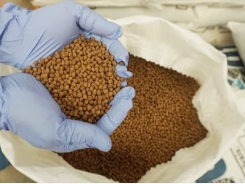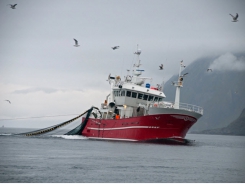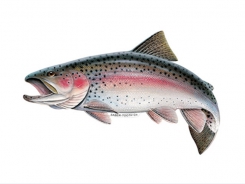Study reveals valuable insights into farmed salmon health and welfare

Juvenile salmon experience higher mortalities if transferred to sea at a larger size, according to an extensive new study based on eight years of data.
René Alvestad defended his PhD thesis about the challenges of analysing large scale commercial salmon farming data on 15 June. Photo: Wilhelm Solheim, Nofima
So discovered René Alvestad, from Nofima, after analysing a very large production dataset sourced from a commercial salmon producer in Northern Norway for his PhD at NTNU. The key aims of his doctorate were to identify risk factors for cause-specific and overall mortality, reduced performance during the seawater ongrowing phase and quality downgrading at harvest.
Surprising discoveries
Alvestad analysed a large commercial database from 2010 to 2018. He found that seawater transfer of smolts with a higher average weight (up to 200 grams) was associated with increased mortality due to mouth rot and the heart diseases HSMB and CMS. A higher proportion of salmon also died of mouth rot when the smolts were transferred to the sea at low and falling seawater temperatures in this specific region.
This historical data also suggested that mechanical de-licing contributed to increased numbers of mortalities associated with HSMB and CMS and also increased overall mortality. Winter sores were the main cause of downgrading at slaughter and were a persistent cause of mortality in the seawater phase of production in this region and timeframe.
Melanin spots were the second most important cause of downgrading at slaughter. Fish groups that had a higher proportion of deaths due to heart-related diseases also had a higher incidence of melanin spots in the fillet at slaughter.
”In summary, I have found that there are many drivers for reduced quality and mortality, but there is no single cause that particularly stands out. However, we do see that it is possible to demonstrate a connection between reduced product quality and certain production strategy factors when we get good access to data at a slaughter facility,” said Alvestad in a press release.
The doctoral thesis showed that the collection and analysis of production data can be a valuable tool for identifying risk factors for reduced fish welfare and reduced product quality in commercial salmon farming.
Highlighting the need for for digitisation and standardisation
Alvestad's doctoral degree was based upon gaining access to a large number of daily measurements in a suitable format. These included a number of parameters such as environmental factors, smolt transfer factors, feeding data and cause specific mortality data.
”What I do requires digitisation, and that there is actually data in the formats I need to analyse,” he reflected.
Alvestad believes there is a need to improve the infrastructure for collecting, handling and sharing data, so that it is easier to identify risk factors and implement measures to combat or circumvent them. This is a general issue for both aquaculture and many other industries.
”One thing we can see is that the industry takes the problem seriously. There are several ongoing initiatives for standardised data collection in the aquaculture industry.
”I have learned that the conditions in commercial farming are much more complicated than one sees in isolation in experiments. I also learned a lot about the industry and some specific regional challenges. Mouth rot is so new and so poorly covered in the literature, that it was surprising that it was so extensive,” says Alvestad.
Related news
Tools

Phối trộn thức ăn chăn nuôi

Pha dung dịch thủy canh

Định mức cho tôm ăn

Phối trộn phân bón NPK

Xác định tỷ lệ tôm sống

Chuyển đổi đơn vị phân bón

Xác định công suất sục khí

Chuyển đổi đơn vị tôm

Tính diện tích nhà kính

Tính thể tích ao




 Reducing egg loss in shrimp hatcheries
Reducing egg loss in shrimp hatcheries  Tackling red mark syndrome in trout farming
Tackling red mark syndrome in trout farming